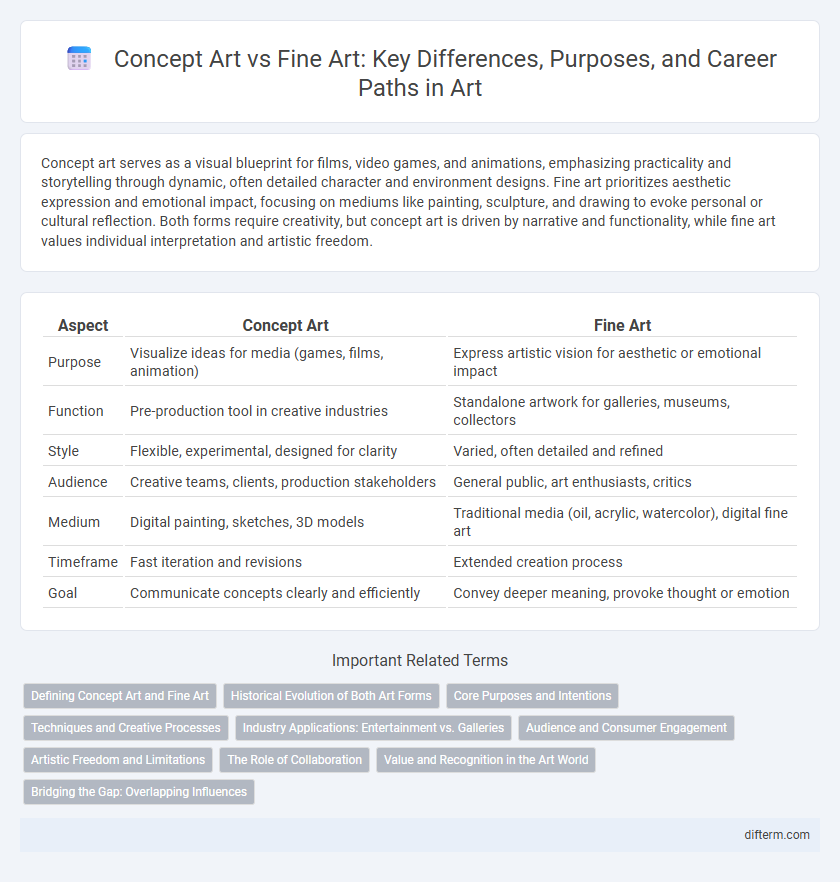Concept art serves as a visual blueprint for films, video games, and animations, emphasizing practicality and storytelling through dynamic, often detailed character and environment designs. Fine art prioritizes aesthetic expression and emotional impact, focusing on mediums like painting, sculpture, and drawing to evoke personal or cultural reflection. Both forms require creativity, but concept art is driven by narrative and functionality, while fine art values individual interpretation and artistic freedom.
Table of Comparison
| Aspect | Concept Art | Fine Art |
|---|---|---|
| Purpose | Visualize ideas for media (games, films, animation) | Express artistic vision for aesthetic or emotional impact |
| Function | Pre-production tool in creative industries | Standalone artwork for galleries, museums, collectors |
| Style | Flexible, experimental, designed for clarity | Varied, often detailed and refined |
| Audience | Creative teams, clients, production stakeholders | General public, art enthusiasts, critics |
| Medium | Digital painting, sketches, 3D models | Traditional media (oil, acrylic, watercolor), digital fine art |
| Timeframe | Fast iteration and revisions | Extended creation process |
| Goal | Communicate concepts clearly and efficiently | Convey deeper meaning, provoke thought or emotion |
Defining Concept Art and Fine Art
Concept art serves as a preliminary visual representation designed to convey ideas and establish the look and feel for films, video games, or animations, often prioritizing storytelling and functionality over aesthetics. Fine art emphasizes creative expression and aesthetic value, encompassing traditional media such as painting, sculpture, and drawing, with the primary intent of evoking emotional or intellectual responses. Both disciplines utilize distinct techniques and purposes, where concept art guides production processes and fine art aims for cultural or personal significance.
Historical Evolution of Both Art Forms
Concept art originated primarily as a functional tool in the entertainment industry during the mid-20th century, evolving to visually communicate ideas and designs for films, video games, and animation. Fine art, with roots tracing back to ancient civilizations, has traditionally emphasized aesthetic, cultural, and intellectual expression through mediums like painting, sculpture, and drawing. Both art forms reflect historical shifts in technology, society, and purpose, with concept art linked to modern digital advancements and fine art deeply embedded in classical artistic traditions.
Core Purposes and Intentions
Concept art primarily serves as a visual development tool aimed at exploring and communicating ideas for media projects such as films, video games, and animations. Fine art focuses on personal expression, aesthetics, and the creation of works intended for exhibition and contemplation, emphasizing originality and emotional depth. The core intention of concept art is functional and collaborative, while fine art prioritizes artistic autonomy and cultural value.
Techniques and Creative Processes
Concept art emphasizes rapid visualization techniques and iterative sketching to develop characters, environments, and narratives primarily for media like video games and films. Fine art involves traditional methods such as painting, sculpture, and printmaking, focusing on personal expression and aesthetic innovation. Both practices rely on strong foundational skills in composition and color theory but diverge in their end goals and creative workflows.
Industry Applications: Entertainment vs. Galleries
Concept art primarily supports the entertainment industry by visualizing characters, environments, and stories for video games, movies, and animation, ensuring cohesive narrative development during production. Fine art emphasizes aesthetic and conceptual value, often displayed in galleries, museums, and private collections to engage viewers through emotional and intellectual experiences. While concept art drives creative direction in commercial projects, fine art serves as a medium for cultural expression and artistic exploration within the traditional art market.
Audience and Consumer Engagement
Concept art primarily targets industry professionals such as game developers and filmmakers, focusing on visual storytelling that guides the production process. Fine art appeals to a broader audience, including collectors and gallery visitors, emphasizing personal interpretation and emotional connection. Consumer engagement in concept art involves functional appreciation and technical analysis, while fine art encourages subjective experience and cultural dialogue.
Artistic Freedom and Limitations
Concept art emphasizes imaginative exploration and visual storytelling, granting artists broad creative freedom to design characters, environments, and narratives unrestricted by traditional aesthetics. Fine art, while allowing personal expression, often involves stricter adherence to established techniques, mediums, and cultural or historical contexts, which can impose limitations on artistic choices. The balance between innovation and tradition defines the distinct freedoms and constraints experienced within these two artistic disciplines.
The Role of Collaboration
Collaboration in concept art involves iterative teamwork among designers, illustrators, and developers to rapidly visualize ideas that drive storytelling and game development. Fine art collaboration, although less frequent, often occurs in interdisciplinary projects where artists blend mediums or co-create installations, enriching the artistic expression. The dynamic interaction in concept art accelerates innovation, while collaborative fine art fosters experimental approaches and shared creative visions.
Value and Recognition in the Art World
Concept art holds significant value in the creative industries, particularly in film, video games, and animation, where it drives visual storytelling and design development. Fine art commands lasting recognition in galleries and museums, often appreciated for its historical, cultural, and aesthetic significance beyond commercial purposes. The art world increasingly acknowledges the unique contributions of both, valuing concept art for innovation and fine art for its enduring cultural impact.
Bridging the Gap: Overlapping Influences
Concept art and fine art share overlapping influences that bridge creative expression and practical application, often enriching each other's techniques and narratives. Concept artists utilize fine art principles such as composition, color theory, and anatomy to develop visual storytelling for media like video games and films. Fine artists increasingly incorporate conceptual approaches to explore deeper themes and experiment with new mediums, blurring traditional boundaries between the two disciplines.
concept art vs fine art Infographic

 difterm.com
difterm.com